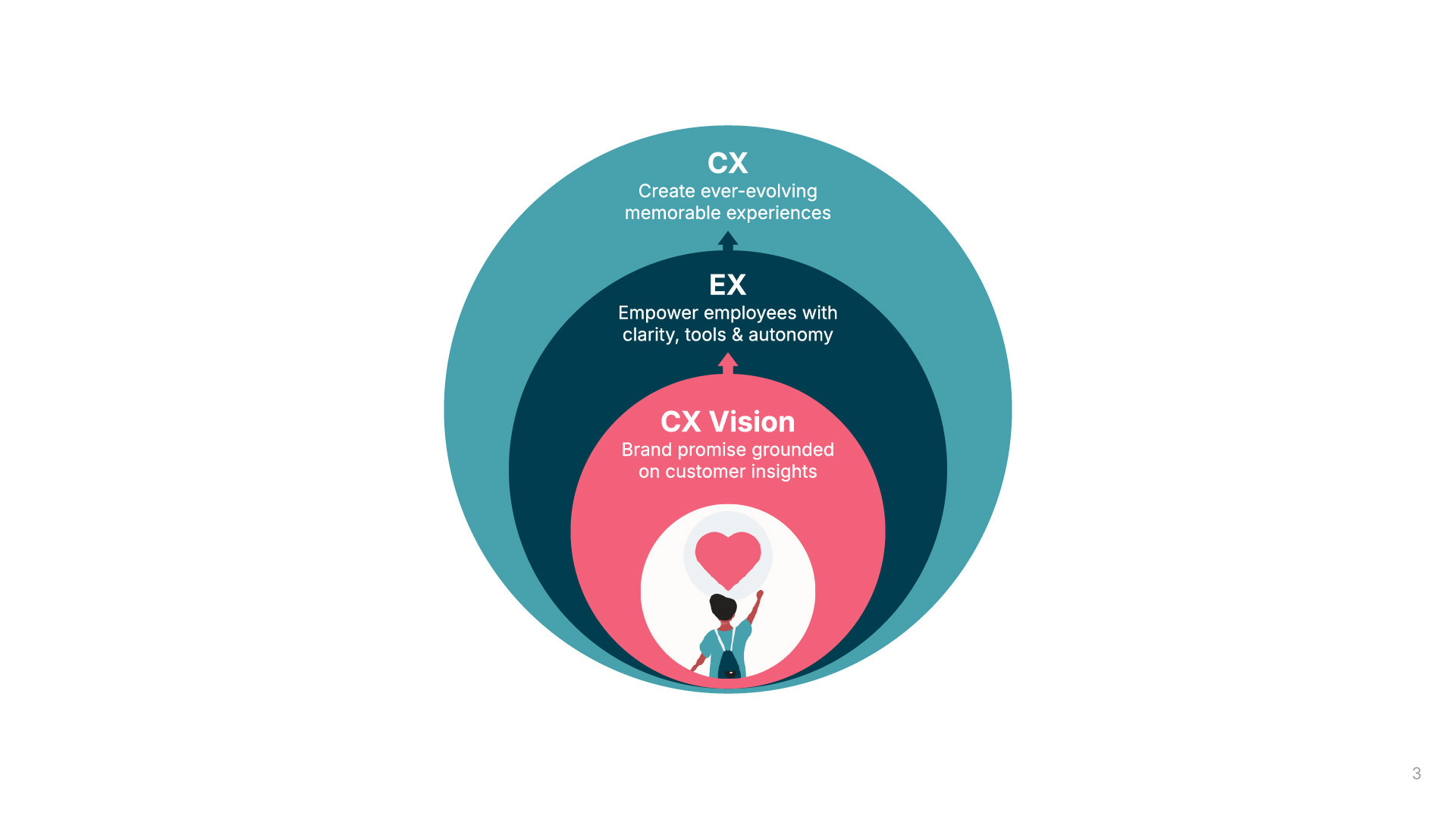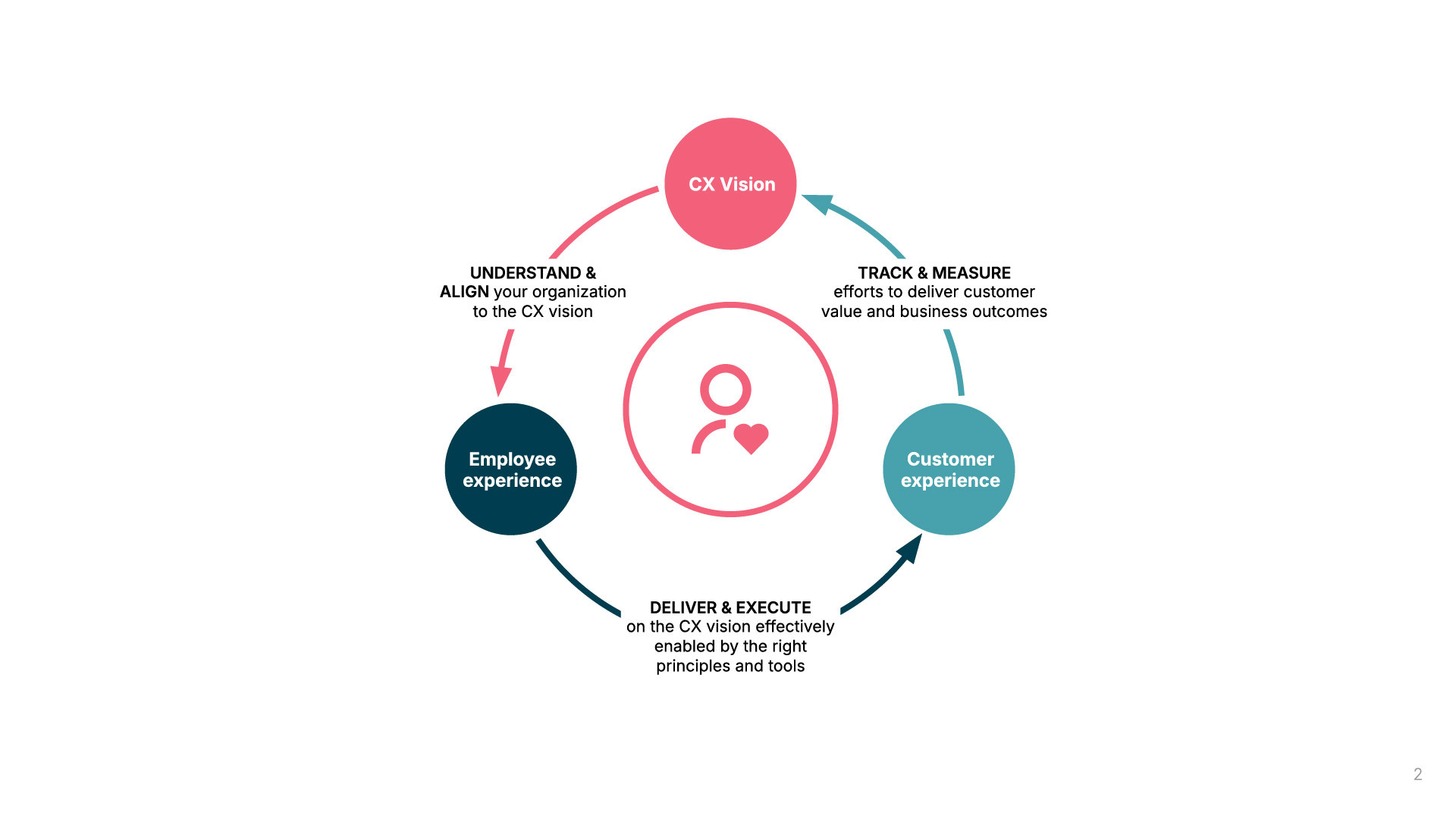Think back to a time you had an amazing customer experience. What stood out? Was it the employee’s warmth, their ability to anticipate your needs or how effortlessly they resolved your issue? Now, think of a not-so-great experience. Did it feel like the person helping you was stuck, frustrated or simply going through the motions?
Here’s the truth: every customer experience is powered by the employee behind it, and those employees can only deliver greatness if they’re set up for success.
This blog is an invitation to pause and reflect on what’s happening inside your organization — and why investing in your people is one of the most powerful ways to elevate your customer experience (CX).
Start from within: Why EX shapes CX
We all know that great CX is a competitive advantage. Seamless, personalized interactions are no longer a luxury — they’re expected. Yet so many companies fall short. Why?
Often, it’s not a lack of intent — it’s internal misalignment. Maybe your teams don’t share a unified vision of customer value. Or your data is trapped in silos. Or your employees are using outdated tools, feeling burned out and disconnected from the bigger picture.
Here’s where the shift begins: turning your CX focus inward creating an inside-out ripple effect.


When employees are supported with the right tools, clarity and autonomy, they move from reactive to proactive. They don’t just respond: they create meaningful, memorable experiences.
💡 Ask yourself: Do my employees have what they need to consistently deliver on our brand promise?
The business case: What happens when you prioritize EX
This isn’t just feel-good HR talk. The connection between employee experience (EX) and customer experience is backed by real business results.
Fortune 100 Best Places to Work for 2025 experience 8.5x greater revenue per employee (RPE) than the U.S. public market RPE.
Here’s what organizations see when they put employees at the center:
Faster, more personalized service Empowered employees — especially with tools like AI that streamline workflows can resolve issues quickly, tailor their responses and create smoother journeys.
Higher engagement and alignment. When people understand the brand, believe in it and see how their work contributes to it, motivation skyrockets. It’s easier to deliver on CX goals when employees feel included in shaping them.
Better business performance. Engaged employees deliver better service, spot opportunities for improvement and help the business respond faster to change. All of this adds up to better business performance, increased customer loyalty and even revenue growth.
Stronger brand consistency. When employees understand what the brand stands for, how they support it, experience it themselves internally and have autonomy to make decisions, they start delivering more consistent experiences.
Culture of learning and agility. Feedback loops between employees and systems lead to continuous refinement of internal processes. As EX evolves, CX follows suit, leading to ongoing enhancements across the board.
💡 Let's take a quick pulse-check: Are your employees trusted to make customer-first decisions in the last responsible moment?
Real impact, real people: When empowerment meets action
This not only applies to business: the positive impact of EX can also benefit government agencies, even more so because their programs are critical to their communities.
When working with the Department of Employment Security, we identified that many claimants were overwhelmed by legal-heavy communications about their unemployment benefits. Unsure of what to do, many turned to the call center, driving up wait times, frustration and a growing sense that the system was working against them.
The solution? Thoughtworks designed an AI-powered tool that helps staff attach plain-language explanations to legal correspondence — helping cut through confusion and proactively guide claimants through next steps.
While the project is still underway, we’re already seeing its potential: fewer calls, better communication, increased accessibility to benefits and a stronger sense of trust. For staff, it means less time untangling issues and more confidence in helping people right away. This is what thoughtfully designed employee experience can do: it enables employees to work more effectively and empowers people to feel seen, supported and informed.
Where to focus: Actions that drive both EX and CX
Ready to bring this mindset into your organization? Start here:
Deeply understand your customer. Use Journey Maps and interviews to uncover what really matters to your users. Go beyond pain points — identify signature moments that carry the most emotional or functional weight. This understanding should inform your CX vision and uncover opportunities for internal improvements.
→ Ask: where do internal systems support or sabotage these moments?
Spot internal friction. What’s slowing your employees down? Where are they jumping through hoops just to help a customer? What data can help them make better decisions? Service Blueprints can help here by mapping the behind-the-scenes processes that support each customer touchpoint. This makes it easier to align teams’ with customer impact and identify the disconnects between what customers see and what employees experience.
Clarify your CX vision. Don’t leave your brand promise open to interpretation. Use frameworks like the Horizon Model to break down your CX ambitions into clear short, mid and long-term goals making progress easier to track and prioritize. Then bring those goals to life with visual storytelling like storyboards that illustrate what great customer experiences actually look like in practice. These tools help teams across the business see the vision, understand their role in it and stay aligned as they deliver it.
→ Ask: Can every employee explain how their work contributes to this vision?
Design for your employees, too. Treat internal systems like you would any customer-facing product. When you apply product thinking to the tools your teams use every day, you uncover opportunities to simplify decision-making, reduce rework and surface useful insights — all of which shape how employees show up for your customers.
→ Think: Would your employees choose your internal tools if given the choice?
Want to go deeper? Explore practical ways to bring this mindset to life in our Product Thinking Playbook.
Empower with strategic AI. Not all AI is helpful — start by understanding the decisions your employees make and what cognitive tasks and mental and emotional load those decisions require. Then choose or design AI tools that ease that load, support better judgment and leave room for human agency where it matters.
AWS tools like Amazon Q for Connect and SageMaker are already supporting real-time customer interactions by offering agents recommended responses, next steps and relevant knowledge articles. But effectiveness depends on fit — it's worth assessing whether these tools match your needs.
See how organizations like The Crown Estate, Visa and Google Cloud are using AI to elevate both employee and customer experiences in our webinar: AI and CX: Redefining customer experiences and products.
Keep evolving. Both customer experience and employee experience are ever evolving. Build feedback loops. Make space to test, learn and iterate and be ready to adapt your strategies and horizons based on what the data tells you. Celebrate small improvements — they add up fast.
💡 Try this: Ask three frontline employees what slows them down — and what would help them move faster. Start there.


Final thought: From the inside out
Great CX isn’t just about optimizing a journey. It’s about honoring the people who bring it to life every day — your employees. The link between exceptional employee experience and exceptional customer experience is undeniable. By making a conscious effort to invest in your employees, provide them with the right tools and support, and foster a culture of engagement, learning and adaptability, you are not only improving their work lives but also laying the groundwork for lasting customer satisfaction and business success.
Embracing an inside-out approach to CX is not just a trend; it's the key to building a resilient and customer-centric organization that thrives in today's dynamic marketplace.
So here’s your challenge:
What would it look like if your internal experience was as thoughtfully designed as your customer experience?
Because when your employees thrive, your customers do too. And that’s when your brand becomes unforgettable.
Disclaimer: The statements and opinions expressed in this article are those of the author(s) and do not necessarily reflect the positions of Thoughtworks.


















